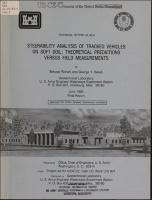Please use this identifier to cite or link to this item:
https://hdl.handle.net/11681/12684Full metadata record
| DC Field | Value | Language |
|---|---|---|
| dc.contributor | Structures Laboratory (U.S.) | - |
| dc.contributor.author | Rohani, Behzad | - |
| dc.contributor.author | Baladi, George Y. | - |
| dc.date.accessioned | 2016-07-06T14:27:15Z | - |
| dc.date.available | 2016-07-06T14:27:15Z | - |
| dc.date.issued | 1982-06 | - |
| dc.identifier.uri | http://hdl.handle.net/11681/12684 | - |
| dc.description | Technical Report | - |
| dc.description | Abstract: In 1978, a terrain-vehicle interaction model was developed by the authors for predicting the steering performance of high-mobility/agility tracked vehicles in environments ranging from very soft soils to hard surfaces. To validate the accuracy of the model for predicting the steering performance of tracked vehicles on soft soils, circular-turn tests were conducted at two sites on a flood plain north of Redwood, Mississippi, and on a dredged spoil area within the WES reservation at Vicksburg, Mississippi. A number of in situ direct shear tests were conducted at each test site and the results used to fit a mathematical soil model with a rate-dependent nonlinear failure envelope for input to the tracked vehicle prediction model. Thirty-five circular-turn tests were conducted at the three test sites, but due to instrumentation problems, complete data were collected for only 16 tests at the Redwood sites. Results from these 16 "good tests" were used to validate both the steady-state and the transient versions of the model. For the transient predictions, Fourier series were fit to the entire measured time histories of the inner and outer track velocities and used as input to the model. Calculated time histories of vrhicle speed, lateral acceleration, power required at the sprockets, and the trajectory of the center of gravity of the vehicle were compared with corresponding test measurements. For the steady-state predictions, five tests were selected and the mean measured radius for each test was used as input to the model. The model output consisted of a maximum vehicle velocity based on either specified stability criteria or power available at the sprockets. Predictions for both transient and steady-state conditions compared very favorably with the test data, indicating that the model is capable of predicting the steering performance of tracked vehicles on soft soil. | - |
| dc.publisher | Geotechnical Laboratory (U.S.) | - |
| dc.publisher | Engineer Research and Development Center (U.S.) | - |
| dc.relation | http://acwc.sdp.sirsi.net/client/en_US/search/asset/1018160 | - |
| dc.relation.ispartofseries | Technical report (U.S. Army Engineer Waterways Experiment Station) ; GL-82-4. | - |
| dc.rights | Approved for public release; distribution is unlimited. | - |
| dc.source | This Digital Resource was created from scans of the Print Resource | - |
| dc.subject | AGIL (Computer program) | - |
| dc.subject | Soil-track interaction | - |
| dc.subject | Computer programs | - |
| dc.subject | Mathematical models | - |
| dc.subject | Terrain-vehicle interaction | - |
| dc.subject | Military vehicles | - |
| dc.subject | Track-laying vehicles | - |
| dc.subject | Rheological models | - |
| dc.subject | Vehicle performance | - |
| dc.title | Steerability analysis of tracked vehicles on soft soil : theoretical predictions versus field measurements | - |
| dc.type | Report | en_US |
| Appears in Collections: | Technical Report | |
Files in This Item:
| File | Description | Size | Format | |
|---|---|---|---|---|
| TR-GL-82-4.pdf | 18.55 MB | Adobe PDF |  View/Open |